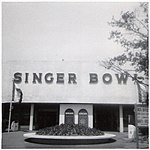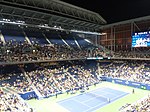USTA Billie Jean King National Tennis Center

The USTA Billie Jean King National Tennis Center is a stadium complex within Flushing Meadows–Corona Park in Queens, New York City, United States. It has been the home of the US Open Grand Slam tennis tournament, played every year in August and September, since 1978 and is operated by the United States Tennis Association (USTA). The facility has 22 courts inside its 46.5 acres (0.188 km2; 0.0727 sq mi) and 12 in the adjoining park. The complex's three stadiums are among the largest tennis stadiums in the world; Arthur Ashe Stadium tops the global list with a listed capacity of 23,200. When the facility was built in 1978, all 33 courts used the DecoTurf cushioned acrylic surface, as did Court 17, added in 2011. However, in 2020, the court surfaces were replaced with Laykold.Near Citi Field (home of the New York Mets) as well as LaGuardia Airport, the tennis center is open to the public for play except during the US Open, junior and wood-racquet competitions.Formerly called the USTA National Tennis Center, the facility was rededicated for Billie Jean King on August 28, 2006.
Excerpt from the Wikipedia article USTA Billie Jean King National Tennis Center (License: CC BY-SA 3.0, Authors, Images).USTA Billie Jean King National Tennis Center
Meridian Road, New York Queens
Geographical coordinates (GPS) Address Nearby Places Show on map
Geographical coordinates (GPS)
| Latitude | Longitude |
|---|---|
| N 40.75 ° | E -73.8475 ° |
Address
Arthur Ashe Stadium
Meridian Road
11368 New York, Queens
New York, United States
Open on Google Maps






